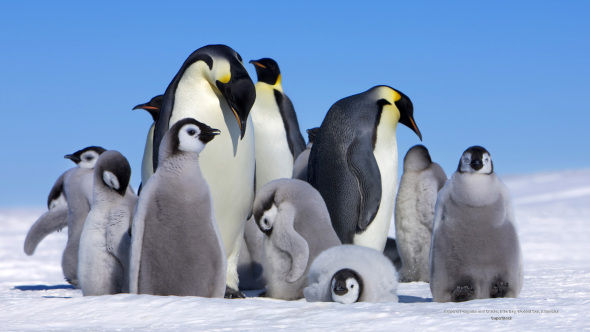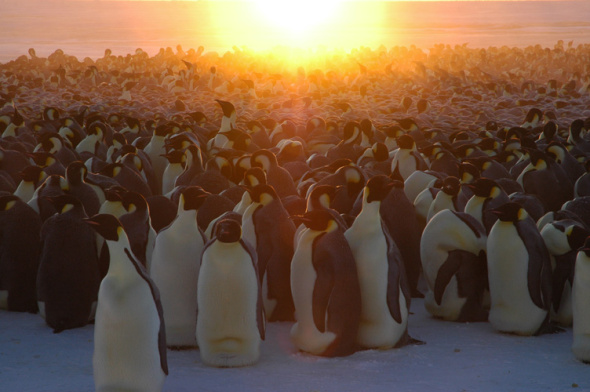Emperor Penguin - The Big Huddle
 HUDDLING together in the white icy blustery winds of an Arctic storm and in temperatures of -50 its hard to fathom that any living creature would be able to survive for any length of time imaginable. HOWEVER - Warm and cuddled together the Aptenodytes forsteri makes a case of happy feet and Arctic traffic jams just to keep warm look like a breeze in the northern winds. Welcome to the Arctic Emperor Penguin a mysterious but cute and cuddly penguin.
HUDDLING together in the white icy blustery winds of an Arctic storm and in temperatures of -50 its hard to fathom that any living creature would be able to survive for any length of time imaginable. HOWEVER - Warm and cuddled together the Aptenodytes forsteri makes a case of happy feet and Arctic traffic jams just to keep warm look like a breeze in the northern winds. Welcome to the Arctic Emperor Penguin a mysterious but cute and cuddly penguin.
FOR most, the start stop motion of a traffic-jam is about as infuriating as it can get., but if you are a group of emperor penguins, its just what you need to stay together.
Emperor penguins huddle together in large groups to survive the Antarctic winter. Researchers interested in how these groups remain closely knit have attached temperature and light sensors to individual birds, but no one had looked at the dynamics of a huddle as a whole.
To see what was gong on Dr Wegener Institute for Polar and Marine Research in Bremerhaven, Germany, filmed huddles and analysed each penguins movements. They found that when one bird steps, it triggers the coordinated movement of its neighbors in a wave-like motion, similar to the ways cars inch forward in a congestion jam.
To find out what triggers these waves, the team applied a mathematical model often used to study and analyse road traffic congestion. It showed rather than simply being caused by cold penguins pushing in, waves can originate from birds at many different spots in the huddle., as long as their steps exceed a 2 centimeter threshold distance, about twice the thickness of their feather layer.
Waves that started in two different groups can merge, helping smaller huddles grow into large throngs that can withstand a shockingly low temperature of up to -50 oc.
Now that’s amazing.
Emperor Penguins are the largest species of Penguin listed as least concern on the IUCN red list of threatened species. They measure up to 1.1 m (3.5 ft) in height and they weigh up to 37 kgs (82 lbs). Their head and wings are black in colour, their back is blue-black and they are coloured white on their front. They have yellow patches on the side of their neck and their bill is purplish-pink.
The feathers of Emperor Penguins are thick, and provide insulation and a waterproof layer over their whole body, except their feet and undersides of their wings. Male Emperor Penguins have an abdominal fold between their legs and lower abdomen that is known as their “brood pouch”. This protects their egg and chick during the breeding season.
Emperor Penguins swim at speeds of 6 - 9 Km/hr (4 - 6 mph) but they can reach speeds of 19 km/hr (12 mph) in short bursts. The call of each Emperor Penguin is distinct and males and females can be identified by their differing calls. On land they alternate between walking and “tobogganing” along on their stomachs, propelling themselves with their feet and wings.
 To protect themselves against the cold, severe weather Emperor Penguins huddle together in what is known as the “turtle formation”. The huddles can consist of 10 or hundreds of birds and each bird leans forward on a neighbour. Those on the outside shuffle slowly around the edge producing a churning action that gives each bird a turn in the middle.
To protect themselves against the cold, severe weather Emperor Penguins huddle together in what is known as the “turtle formation”. The huddles can consist of 10 or hundreds of birds and each bird leans forward on a neighbour. Those on the outside shuffle slowly around the edge producing a churning action that gives each bird a turn in the middle.
Habitat
Emperor Penguins are found circumpolar around Antarctica. They are social birds and they feed, travel and nest in groups. They are active during the day or night and from January to March they disperse into the ocean.
Diet
Emperor Penguins feed on small fish, squid and crustaceans. They mainly dive to around 50 m (164 ft) to forage for food and one of their feeding strategies is to blow bubbles into cracks in the ice to flush out any fish that may be hiding.
Breeding
Emperor Penguins breed in winter and will travel approximately 90 km (56 miles) inland to their breeding site. In May or June the female will lay 1 egg that weighs approximately 450g (1 lb) then she leaves it with the male while she goes out to sea to feed and build up her nutritional reserves.
The male carries the egg on his feet and protects it with a pouch of feathery skin. He incubates it for approximately 65 days and during this time he will not feed, surviving on the fat reserves he has built up. All the males huddle together to keep warm while they wait for their egg to hatch and the female to return.
In spring the female returns and the chick emerges from its egg. If the chick hatches before the female has returned with food, the male will produce a milky substance from a gland in his digestive system to feed the chick. After the female has returned the males then leave to go out to sea to feed, later returning to help rear the chick.
When the chicks are approximately 2 months old they will join other young penguins in a creche, but they are still fed by their parents. After approximately 5 months the young birds and their parents will return to the sea to feed for the rest of the summer.
Emperor Penguins become sexually mature at around 5 years of age. Those that are not of breeding age remain at the edge of the sea during the winter months, while the breeding adults make the trek inland.
Predators
The main predators of Emperor Penguins are leopard seals, killer whales, sharks, skua and antarctic giant petrels.
Subspecies
There are no subspecies of the Emperor Penguin.
Interesting Facts
Emperor Penguins can dive up to 530 m (1,750 ft) for as long as 20 minutes - they hold the record for the deepest and longest dive from a bird. It was believed that the endangered Spheniscus demersus - African penguin held this record however this is false, they are though one of the fastest penguin swimmers in the oceans to date.
Emperor Penguins are the 5th heaviest bird currently in existence and are the only penguins to breed during the winter months and they endure very severe breeding conditions. In the 2006 film Happy Feet, the main character was an Emperor Penguin called Mumble and he befriended a group of cuban-accented Adelie Penguins.
Emperor Penguins belong to the genus Aptenodytes, which also includes: - King Penguin - Aptenodytes patagonicus.
For more information on marine and Arctic environmentalism contact us at externalaffairs@international-animalrescue-foundation.org.uk
Alternatively visit our Marine Conservation Society Organisation here.




Thank you for your reply, should it merit a response we will respond in due course. This site is owned by International Animal Rescue Foundation and moderation is used.